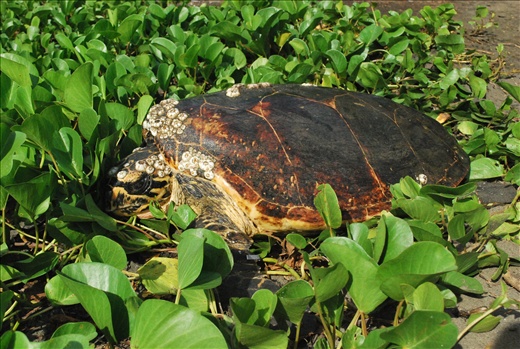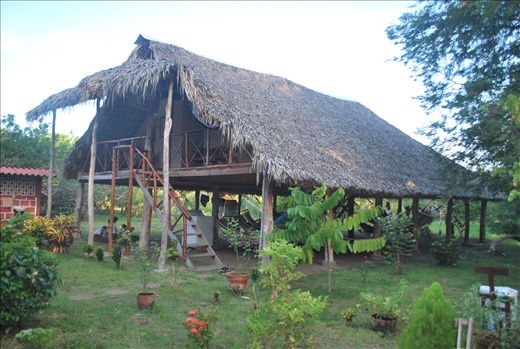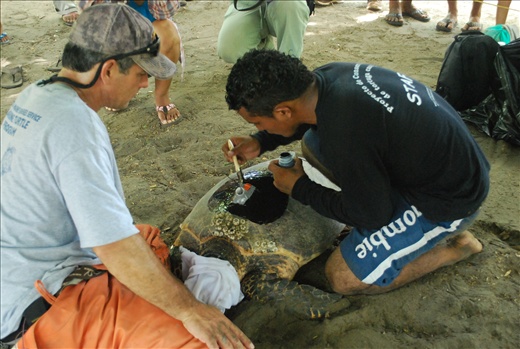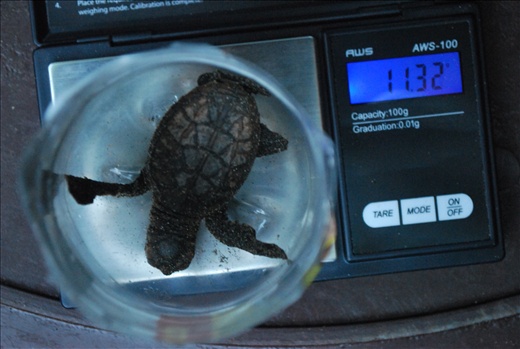A wide beach on a warm clear evening may be the most relaxing setting on earth. We weren’t likely to come across any nesting turtles on this beautiful evening in the far northwest corner of Nicaragua (the tides weren’t right), but we didn’t mind. The soft sound of surf provided a soundtrack for the brightest Milky Way I’ve seen in years. Just being out on the sand was enough entertainment. But we didn’t travel 10 hours by bus from El Salvador for a tranquil beach walk.

We came to Padre Ramos Estuary because it is home one of the world’s most inspiring sea turtle conservation projects. Our motley group of international sea turtle experts was there as part of a research expedition to study and protect one of the world’s most endangered turtle populations, the Eastern Pacific hawksbill sea turtle. Led by the Nicaraguan staff of Fauna & Flora International (FFI, an international conservation group) and carried out with support from the Eastern Pacific Hawksbill Initiative (known as ICAPO), this turtle project protects one of only two major nesting areas for this population (the other is El Salvador’s Jiquilisco Bay). This project depends on the participation of local residents; a committee of 18 local non-profit organizations, community groups, local governments, and more.
The coastal road leading into the town of Padre Ramos felt like many other spots along Central America’s Pacific coast. Small cabinas line the beach, allowing surfers a place to spend a few hours out of the water each night. Tourism has barely touched the main town however and the stares of the local kids hinted that gringos are not yet a common sight walking around town.

After arriving at our cabinas, I grabbed my camera and took a walk through town. A late afternoon soccer game competed with swimming in the cool water for the favorite pastime of the residents. I walked out to the beach as the sun set and followed it north to the mouth of the estuary, which curls around the town. The flattened crater of the Cosigüina volcano overlooks the bay and several islands.
The next day, fully rested, we set off early in two boats to try to catch a male hawksbill in the water. Most of the turtles studied in this region have been females easily caught on the beach after nesting. We spotted a hawksbill alongside an island called Isla Tigra, directly in front of the Venecia Peninsula, and the team sprung into action, one person hopping out of the boat with the tail end of the net while the boat swung around in a large semicircle, the net spreading out behind the boat. Once the boat reached the shoreline, everyone hopped out to help pull in the two ends of the net, unfortunately empty.
Despite our poor luck at catching turtles in the water, the team was able to capture the three turtles we needed for the satellite tagging research event. We brought one turtle from Venecia, which is located across the bay from the town of Padre Ramos, to involve members of the community who participate with the project in the satellite tagging event. Little is known about these turtles, but satellite transmitters have been part of a groundbreaking research study that has changed how scientists view the life history of this species. One finding that surprised many turtle experts was the fact that these hawksbills prefer to live in mangrove estuaries; up till then most believed they almost exclusively lived in coral reefs.

A few dozen people gathered around as our team worked to clean the turtle’s shell of algae and barnacles. Next, we sanded the shell to provide a rough surface on which to glue the transmitter. After that, we covered a large area of the carapace with layers of epoxy to ensure a tight fit. Once we attached the transmitter, a piece of protective pvc tubing was placed around the antenna to protect it from roots and other debris that might knock the antenna loose. The final step was to paint a layer of anti-fouling paint to prevent algae growth.
Next, we headed back to Venecia to put two more transmitters on turtles near the project hatchery, where hawksbill eggs are brought from around the estuary to be protected until they hatch and then are released. The tireless efforts of several local “careyeros” (the Spanish term for people who work with the hawksbill, known as “carey”) was rewarded with the opportunity to work with cutting edge technology on this important scientific study. Their pride in their work was obvious in their smiles as they watched the two turtles make their way to the water once the transmitters were attached.
Turtle conservation in Padre Ramos is more than just attaching electronics to their shells. Most of the work is done by the careyeros under the cover of darkness, driving their boats throughout the estuary looking for nesting hawksbills. Once one is found, they call the project staff who attach a metal ID tag to the turtles’ flippers and measure the length and width of their shells. The careyeros then bring the eggs to the hatchery and earn their pay depending on how many eggs they find and how many hatchlings emerge from the nest.
It was only a couple of years ago that these same men sold these eggs illegally, pocketing a few dollars per nest to give men unconfident in their libido an extra boost. Now, most of these eggs are protected; last season more than 90% of the eggs were protected and more than 10,000 baby sea turtles made it safely to the water through the work of FFI, ICAPO, and their partners. These turtles still face several threats in the Padre Ramos Estuary and throughout their range. Locally, one of their biggest threats is from the rapid expansion of shrimp farms into the mangroves.

One of the tools that FFI and ICAPO hope to use to protect these turtles is to bring volunteers and ecotourists to this beautiful spot. A new volunteer program offers budding biologists the opportunity to spend a week to a few months working with the local team to manage the hatchery, collect data on the turtles, and help to educate the community about why it’s important to protect these turtles. For tourists, there is no shortage of ways to fill both days and nights, from surfing, swimming, participating in walks on the nesting beach, hiking, and kayaking.
On my final morning in Padre Ramos, I woke up early to be a tourist, hiring a guide to take me on a kayaking excursion through the mangrove forest. My guide and I paddled across a wide channel and up through increasingly narrow waterways that challenged my limited ability to navigate. Halfway through, we stopped at a spot and walked up a small hill with a panoramic view of the area.
From above, the estuary, which is protected as a natural reserve, looked remarkably intact. The one obvious blemish was a large rectangular shrimp farm that stood out from the smooth curves of the natural waterways. Most of the world’s shrimp is now produced this way, grown in developing countries with few regulations to protect the mangrove forests that many creatures depend upon. While crossing the wide channel on the to return trip to town, a small turtle head popped up out of the water to take a breath about 30 feet in front of me. I like to think it was saying “hasta luego”, until I’m able to return again to this magical out of the way corner of Nicaragua.
Get Involved:
Fauna & Flora Nicaragua website
Volunteer with this project! – Come participate with this project, helping local researchers manage the hatcheries, tag turtles, and release hatchlings. The cost is $45/day which includes food and lodging in local cabinas.
Check out SEEtheWILD's Nicaragua Vacations
Volunteer Work with Sea Turtles